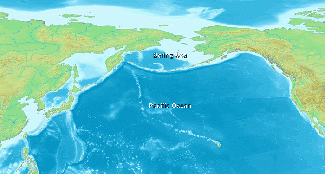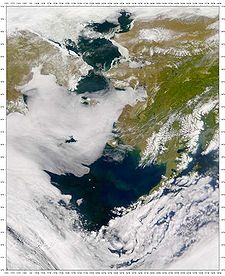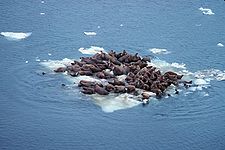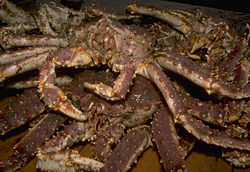Bering Sea
The Bering (or Imarpik[citation needed]) Sea is a body of water in the Pacific Ocean that comprises a deep water basin (the Aleutian Basin) which rises through a narrow slope into the shallower water above the continental shelves.
The Bering Sea is separated from the Gulf of Alaska by the Alaska Peninsula and Aleutian Islands. Covering over two million square kilometers (775,000 sq mi), it is bordered on the east and northeast by Alaska, on the west by Russia's Siberia and Kamchatka Peninsula, on the south by the Alaska Peninsula and the Aleutian Islands and on the far north by the Bering Strait which separates the Bering Sea from the Arctic Ocean's Chukchi Sea. Bristol Bay is the portion of the Bering Sea which separates the Alaska Peninsula from mainland Alaska. The Bering Sea is named for the first European discoverer to sail its waters, the Danish navigator Vitus Bering.
The Bering Sea ecosystem includes resources within the jurisdiction of the United States and Russia, as well as international waters in the ‘Donut Hole’. The interaction between currents, sea ice, and weather make for a vigorous and productive ecosystem.
Geography
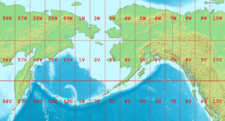
Ecosystem
The Bering Sea Shelf break is the dominant driver of primary productivity in the Bering Sea. [1] This zone, where the shallower continental shelf drops off into the Aleutian Basin is also known as the “Greenbelt”. Nutrient upwelling from the cold waters of the Aleutian basin flowing up the slope and mixing with shallower waters of the shelf provide for constant production of phytoplankton.
The second driver of productivity in the Bering Sea is seasonal sea ice that, in part, triggers the spring phytoplankton bloom. Seasonal melting of sea ice causes an influx of lower salinity water into the middle and other shelf areas, causing stratification and hydrographic effects which influence productivity. [2] In addition to the hydrographic and productivity influence of melting sea ice, the ice itself also provides an attachment substrate for the growth of algae as well as interstitial ice algae. The productivity associated with sea ice is under threat as global warming causes a reduction of sea ice in the Bering Sea.
Some evidence suggests that great changes to the Bering Sea ecosystem have already occurred. Warm water conditions in the summer of 1997 resulted in a massive bloom of low energy coccolithophorid phytoplankton. [3] A long record of carbon isotopes, which is reflective of primary production trends of the Bering Sea, exists from historical samples of bowhead whale baleen. [4] Trends in carbon isotope ratios in whale baleen samples suggest that a 30-40 percent decline in average seasonal primary productivity has occurred over the last 50 years. [4] The implication is that the carrying capacity of the Bering Sea is much lower now than it has been in the past.
Biodiversity
The Bering Sea is home to some of the world's most interesting wildlife. This sea supports many endangered whale species including bowhead whale, blue whale, fin whale, sei whale, humpback whale, sperm whale, and the rarest whale in the world, the North Pacific Right Whale. Other marine mammals include walrus, Steller's sea lion, Northern Fur Seal, Beluga whales, Orcas (or Killer Whale), and polar bears.
The Bering Sea is very important to the seabirds of the world. Over 30 species of seabirds and approximately 20 million individuals breed in the Bering Sea region. Seabird species include tufted puffins, the endangered Short-tailed Albatross, Spectacled Eider, and Red-legged Kittiwakes. Many of these species are unique to the area, which provides highly productive foraging habitat, particularly along the shelf edge and in other nutrient-rich upwelling regions, such as the Pribilof, Zhemchug, and Pervenets canyons.
Two Bering Sea species, the Steller's Sea Cow (Hydrodamalis gigas) and spectacled cormorant (Phalacrocorax perspicillatus), are extinct because of overexploitation by man. In addition, a small subspecies of Canada goose, the Bering Canada goose (Branta canadensis asiatica) is extinct due to over-hunting and introduction of rats to their breeding islands.
The Bering Sea supports many species of fish. Some fish species support large and valuable commercial fisheries. Commercial fish species include 6 species of Pacific salmon, walleye pollock, red king crab, Pacific cod, Pacific halibut, yellowfin sole, Pacific ocean perch and sablefish.
Fish biodiversity is high, and at least 419 species of fish have been reported from the Bering Sea.
Islands
Islands of the Bering Sea include:
- Pribilof Islands
- Komandorski Islands, including Bering Island
- St. Lawrence Island
- Diomede Islands
- King Island
- St. Matthew Island
- Karaginsky Island
Regions of the Bering Sea include
- Bering Strait
- Bristol Bay
The Bering Sea contains 16 submarine canyons including the largest submarine canyon in the world, Zhemchug canyon.
History
Most scientists believe that during the most recent ice age, sea level was low enough to allow humans and other animals to migrate on foot from Asia to North America across what is now the Bering Strait. This is commonly referred to as the "Bering land bridge" and is believed by some—though not all— to be the first point of entry of humans into the Americas.
There is a small portion of the Kula Plate in the Bering Sea. The Kula Plate is an ancient tectonic plate that used to subduct under Alaska during the Triassic period.
Industry
Bering Sea fisheries
Commercial fishing is big business in the Bering Sea, which is relied upon by the largest seafood companies in the world to provide fish and shellfish. It is renowned for its enormously productive and profitable fisheries, such as King Crab,[5] opilio and tanner crabs, Bristol Bay salmon, pollock and other groundfish.
Bristol Bay, the eastern-most arm of the Bering Sea, is home to the world's largest sockeye salmon fishery as well as strong runs of chum salmon, silver salmon and king salmon, each occurring seasonally. Its associated canneries, sport fishing, hunting and tourism, especially to nearby Katmai National Park and Preserve, are additional sources of commerce.
On the U.S. side, commercial fisheries catch approximately $1 billion worth of seafood annually (half the national catch of fish and shellfish), while Russian Bering Sea fisheries are worth approximately $600 million annually.
These world's fisheries rely on the productivity of the Bering Sea via a complicated and little understood food web. The continued existence of these fisheries requires an intact, healthy, and productive ecosystem. Atmospheric and oceanic processes in the Arctic Ocean to the north and the North Pacific Ocean to the south influence the Bering Sea; it shares properties of both and is neither truly polar nor typically north temperate in character. The greatest ecological concern is the warming of Arctic waters and melting of ice.
Oil and mineral development
The area has also experienced significant interest in oil and mineral development, most notably with the proposed Pebble Mine on the north shore of Iliamna Lake, and auctioning of leases to tracts in the southern Bristol Bay area known as the North Aleutians Basin, an area which has been closed to offshore oil and gas development since a moratorium in 1998. [6] There is also a proposal to open most of the BLM's 3.6 million acres (15,000 km²) in the area to hard rock mining and oil and gas drilling.
See also
- Bering Sea Arbitration
- Bristol Bay
Notes
- ↑ Springer, A.M., C.P. McRoy, and M.V. Flint. 1996. "The Bering Sea green belt: shelf-edge processes and ecosystem production." Fisheries Oceanography 5: 205-223.
- ↑ Schumacher, J.D., T. J. Kinder, D. J. Pashinski, and R. L. Charnell. 1979. "A structural front over the continental shelf of the eastern Bering Sea." Journal Physical Oceanography 9: 79-87.
- ↑ Stockwell, Dean A., Terry E. Whitledge, Stephan I. Zeeman, Kenneth O. Coyle, Jeffrey M. Napp, Richard D. Brodeur, Alexei I. Pinchuk, and George L. Hunt. 2001. "Anomalous conditions in the south-eastern Bering Sea, 1997: nutrients, phytoplankton and zooplankton". Fisheries Oceanography. 10 (1): 99-116.
- ↑ 4.0 4.1 Schell, D. M. 2000. "Declining carrying capacity in the Bering Sea: isotopic evidence from whale baleen." LIMNOLOGY AND OCEANOGRAPHY. 45: 459-462.
- ↑ Alaska Fisheries Science Center. Red King Crab, Paralithodes camtschaticus Retrieved October 20, 2008.
- ↑ Pebble Limited Partnership. Pebble Project Retrieved October 20, 2008.
ReferencesISBN links support NWE through referral fees
- Loughlin, Thomas R., and Kiyotaka Ohtani. 1999. Dynamics of the Bering Sea: a summary of physical, chemical, and biological characteristics, and a synopsis of research on the Bering Sea. Fairbanks, Alaska: University of Alaska Sea Grant. ISBN 9781566120623
- National Oceanic and Atmospheric Administration. Bering Sea Climate and Ecosystem Retrieved October 20, 2008.
- National Research Council (U.S.), and NetLibrary, Inc. 1996. The Bering Sea ecosystem. Washington, D.C.: National Academy Press. ISBN 9780585028873
- North Pacific Ocean Theme Page. Bering Sea Retrieved October 20, 2008.
External links
All Links Retrieved October 20, 2008.
- Barbi Failor-Rounds and Krista Milani. Bering Sea-Aleutian Islands area state-waters groundfish fisheries and groundfish harvest from parallel seasons in 2005 Alaska Dept. of Fish and Game.
Coordinates:
Credits
New World Encyclopedia writers and editors rewrote and completed the Wikipedia article in accordance with New World Encyclopedia standards. This article abides by terms of the Creative Commons CC-by-sa 3.0 License (CC-by-sa), which may be used and disseminated with proper attribution. Credit is due under the terms of this license that can reference both the New World Encyclopedia contributors and the selfless volunteer contributors of the Wikimedia Foundation. To cite this article click here for a list of acceptable citing formats.The history of earlier contributions by wikipedians is accessible to researchers here:
The history of this article since it was imported to New World Encyclopedia:
Note: Some restrictions may apply to use of individual images which are separately licensed.
